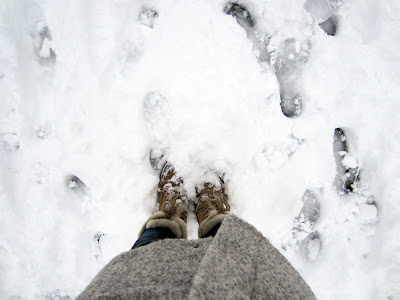At the beginning of February there were reports of snow showers in Rome. Although I'm told that snow is extremely rare this far south on the peninsula, I've experienced it every winter since I've been here. In February 2010 it snowed lightly the day of our Fulbright mid-year meeting, but we were inside all day and unfortunately missed out on all the excitement. The next winter, Katie and I rushed to the center of town when it started sprinkling so that we could see snowflakes fall through the oculus of the Pantheon. Predictions for this storm, however, called for several inches, something that hasn't happened since 1986. Hailing (ha! weather puns!) from the northwest, and growing up with hyperbolic weather reports about pending school closures and blizzards (only to then wake up with nothing but a soggy wet lawn), I've become a bit skeptical about snow predictions, and so I took a let's-wait-and-see approach.
That Saturday morning, at about 5:00am, I heard my roommates knocking on my bedroom door, excitedly telling me to look out the window. It had snowed several inches, and it was still coming down. They were going to go out exploring, and asked if I wanted to come. I love me some snow, but I love me some sleep more, so I said I would join them later.
We had standing reservations for a tour that morning of the catacombs beneath St Peter's, and although it was most likely canceled we had no way of knowing, and so we planned on meeting at the Vatican at 9am. I left the apartment at 7:30am, giving myself plenty of time to walk to St Peter's and take lots of pictures along the way. Buses, trams, taxis-- nothing was running-- and needless to say, Rome came to a grinding halt, completely unaware of how to handle such a situation. There was at least a foot and a half of snow on the ground, and even more up north. Where Tom lives for example, in Monterotondo (about 40 min north), there were at least two feet.
When I left the apartment and started my walk there were very few people out. But as I plowed along stories started coming in via text, gchat, and facebook: Claudio had departed from the other roommates and went snowboarding down a hill near the apartment; Emily and Marco were making a snowman in Piazza del Popolo; the Katies were trekking to the Vatican from the Colosseum; Tom went skiing down the streets in his neighborhood. By the time we got out of our tour (spoiler alert: it actually happened!), the city had taken on a party atmosphere, with people gathering in the streets and piazze to build snowmen, have snowball fights, and to take in this rare event.
These are the pictures from my walk:
That Saturday morning, at about 5:00am, I heard my roommates knocking on my bedroom door, excitedly telling me to look out the window. It had snowed several inches, and it was still coming down. They were going to go out exploring, and asked if I wanted to come. I love me some snow, but I love me some sleep more, so I said I would join them later.
We had standing reservations for a tour that morning of the catacombs beneath St Peter's, and although it was most likely canceled we had no way of knowing, and so we planned on meeting at the Vatican at 9am. I left the apartment at 7:30am, giving myself plenty of time to walk to St Peter's and take lots of pictures along the way. Buses, trams, taxis-- nothing was running-- and needless to say, Rome came to a grinding halt, completely unaware of how to handle such a situation. There was at least a foot and a half of snow on the ground, and even more up north. Where Tom lives for example, in Monterotondo (about 40 min north), there were at least two feet.
When I left the apartment and started my walk there were very few people out. But as I plowed along stories started coming in via text, gchat, and facebook: Claudio had departed from the other roommates and went snowboarding down a hill near the apartment; Emily and Marco were making a snowman in Piazza del Popolo; the Katies were trekking to the Vatican from the Colosseum; Tom went skiing down the streets in his neighborhood. By the time we got out of our tour (spoiler alert: it actually happened!), the city had taken on a party atmosphere, with people gathering in the streets and piazze to build snowmen, have snowball fights, and to take in this rare event.
These are the pictures from my walk:
Starting out, near the Ministry of Education on Viale di Trastevere
I actually witnessed someone trying to drive their scooter. It wasn't pretty.
Santa Maria in Trastevere
Piazza Trilussa
Campo dei Fiori
Along Vittorio Emanuele
Chiesa Nuova
Destination reached! There was a party atmosphere in the piazza.
Sotto la neve
After our tour we happened upon this guy. On our walk back through the city we saw tons more snowmen.
Even the nuns were impressed
Ponte S'Angelo























